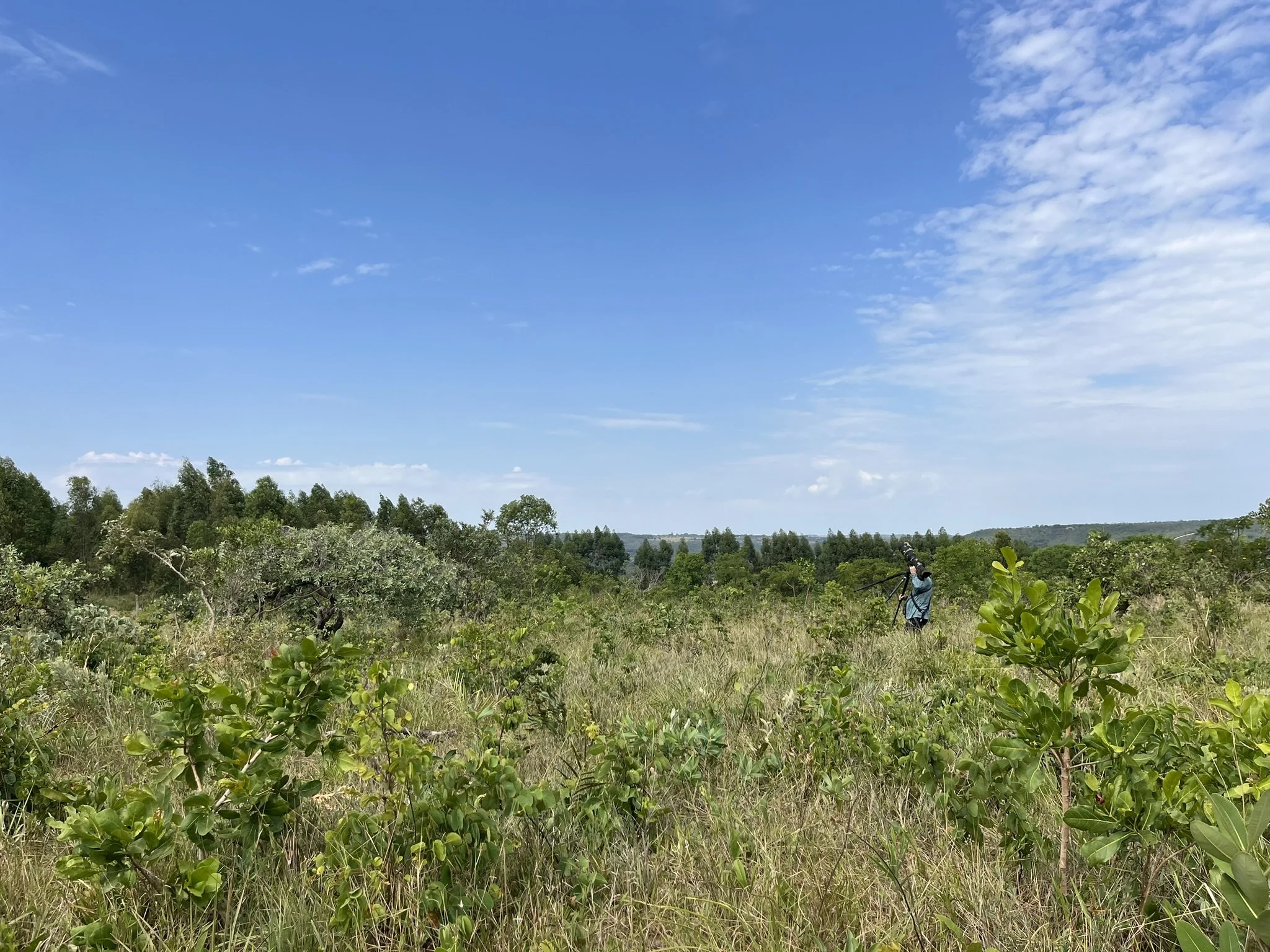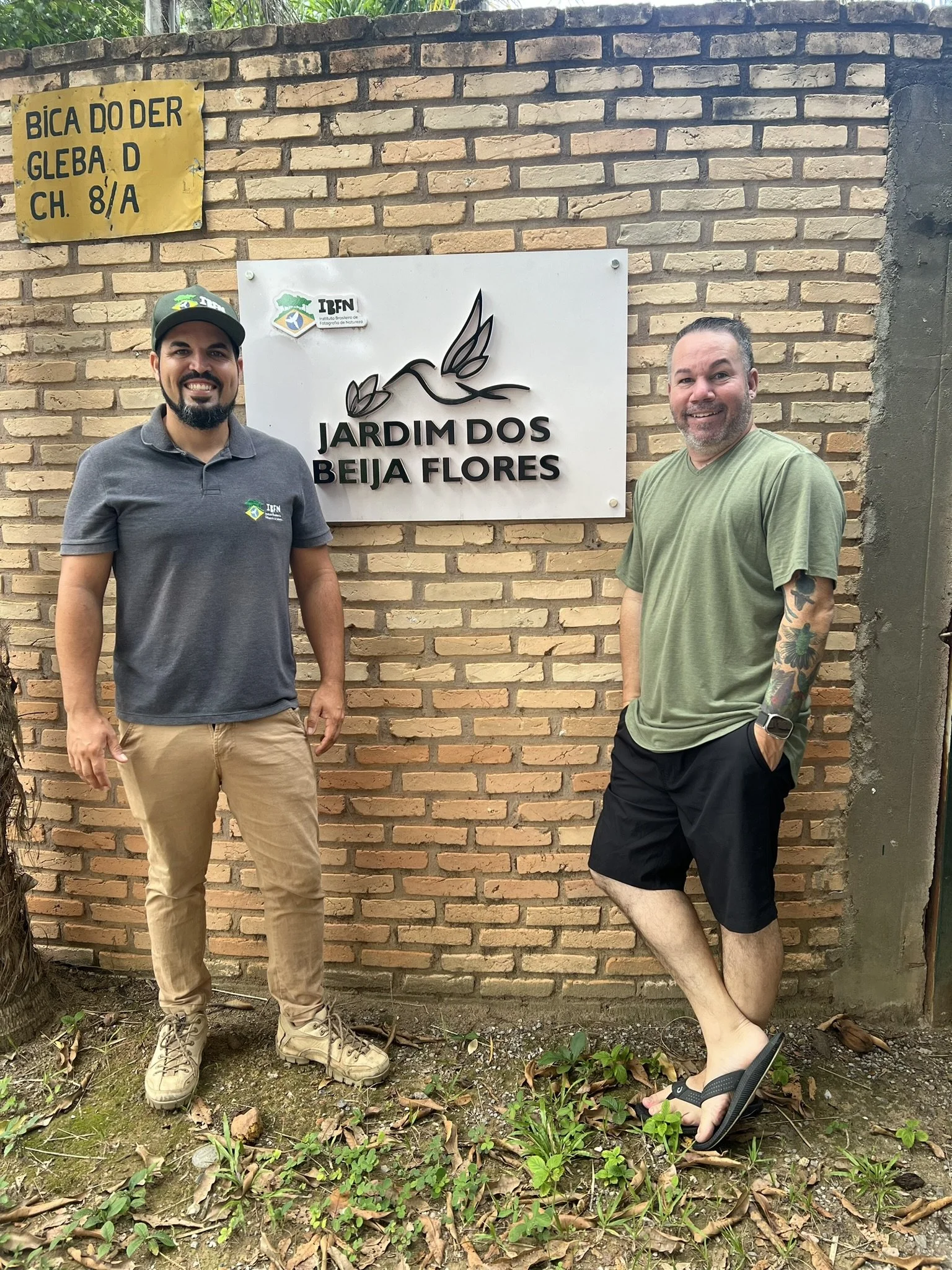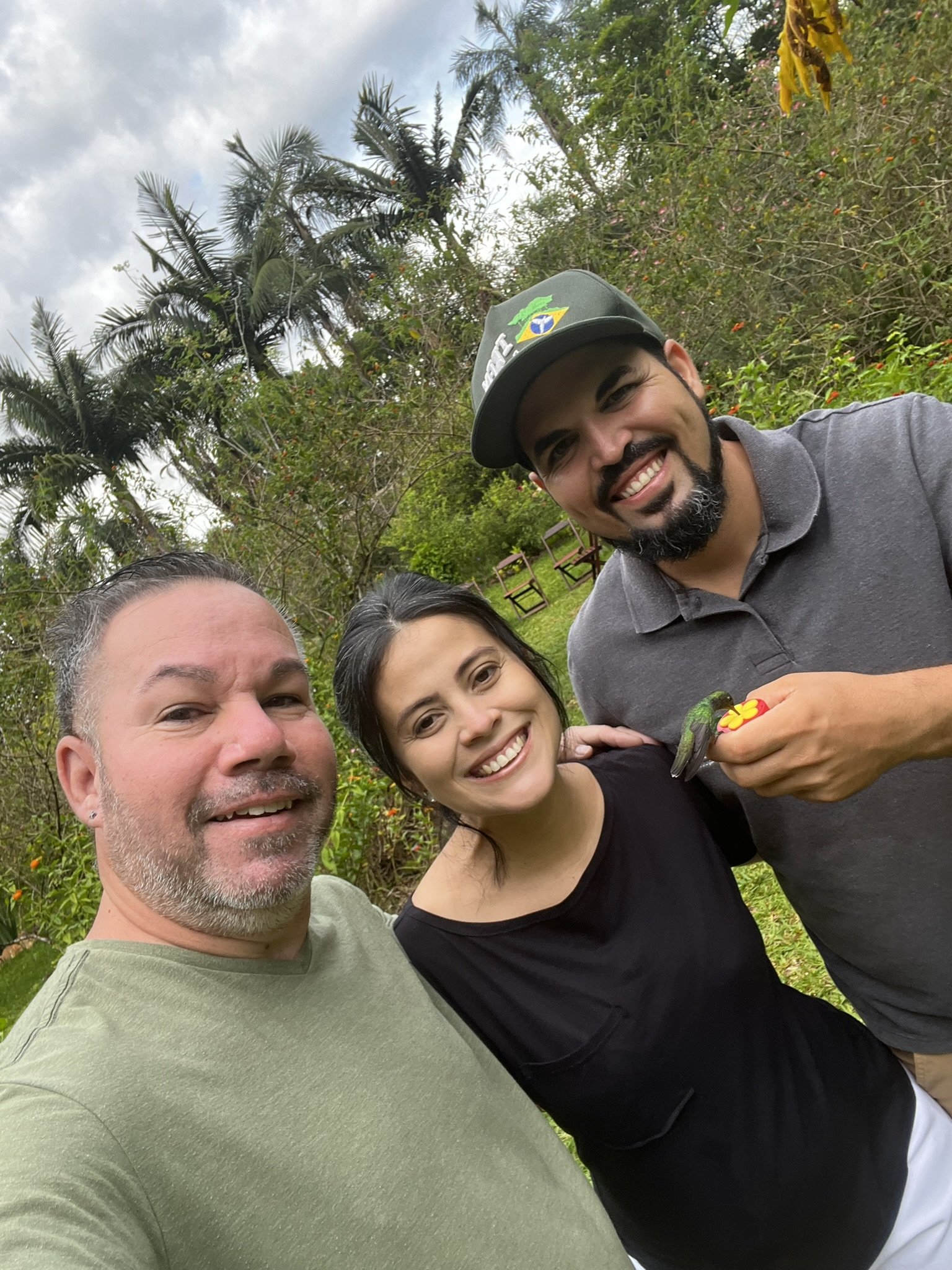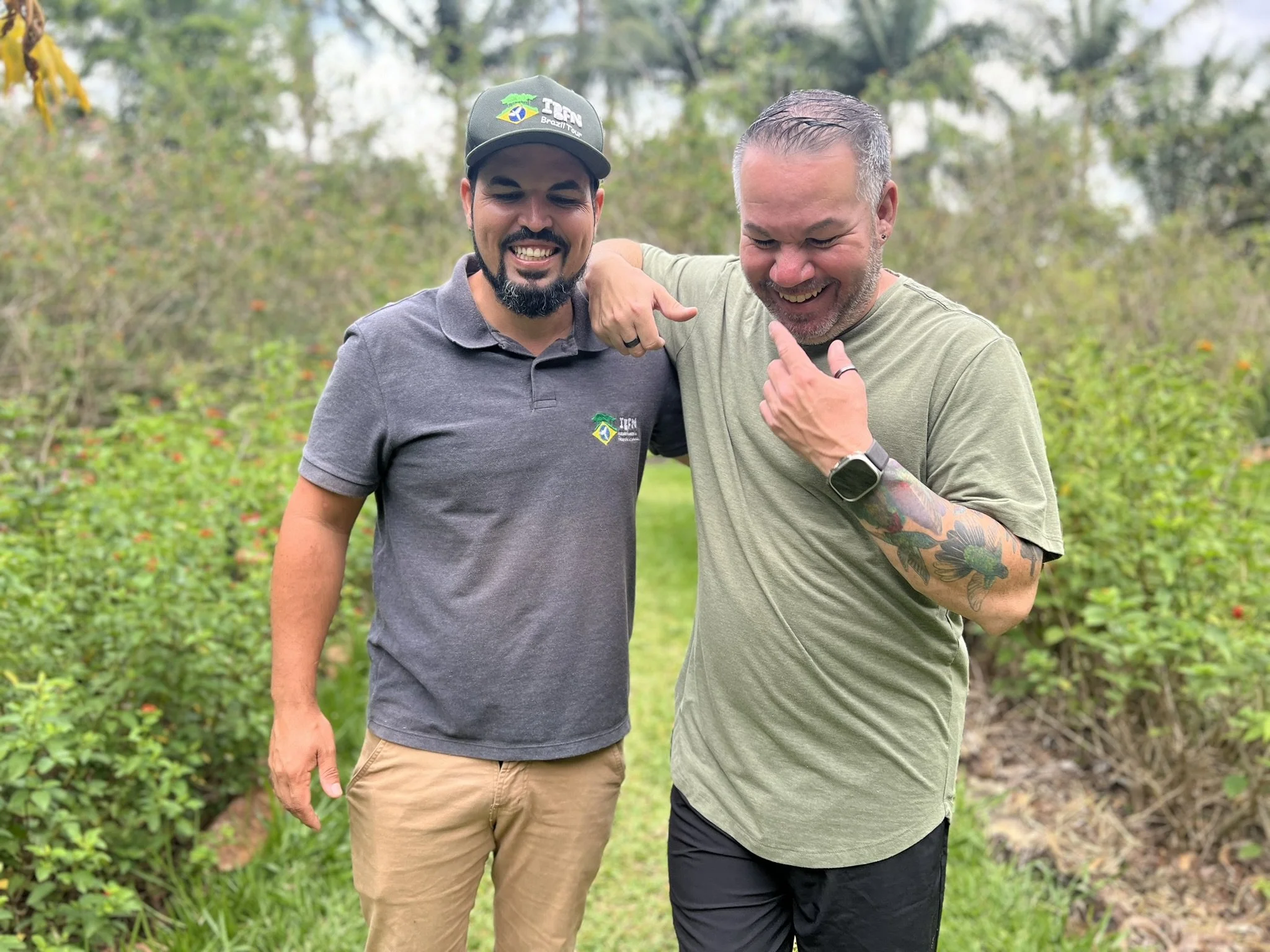How I Photographed the Horned Sungem
Sony A1, Sony 600mm
f/5.6, 1/640, ISO 3200
The Horned Sungem (Heliactin bilophus) has long been on my must-have list! This dazzling hummingbird, with males flaunting a dark blue crown, black throat, chest, and colorful blue, red and gold 'horns,' had to be captured through my lens. While this species can be found in several countries, I chose Brazil for my quest. Not only do I plan to visit Brazil multiple times in the coming years, but I also have not yet explored other countries where this bird resides.
The Journey Begins
Collaborating with my Brazilian photographer, Sergio Gregorio, he meticulously planned my 2023 itinerary with my target hummingbirds in mind. Sergio recommended a local guide, Thiago Tolêdo, for the first leg of my trip in Brasilia. Thiago’s home was conveniently located just a 15-minute drive from the sungem’s known habitat. Upon arrival, Thiago and his family warmly welcomed me. After a quick lunch, we were off to the savannas, equipped with my Sony A1 and Sony 600mm lens.
Thiago shared valuable insights about the sungem's behavior and traits, explaining how close we could get without spooking the birds.
That’s me in the savannas of Brasilia
First Encounter
Our first encounter was electrifying. As we walked a trail adjacent to the road, Thiago pointed out where he had often seen the sungem perched. Suddenly, there it was – a magnificent male Horned Sungem! My 600mm lens was up in an instant, and I captured the moment; despite the challenge of hand-holding the heavy lens and shaky hands and uneven terrain, I snapped away, making sure I didn’t miss the moment. Unfortunately, the bird took off before I could set up my tripod.
Day Two: Unexpected Discoveries
The following day, Thiago and I set out to explore a range of different locations, but these were all places that Thiago knew exceptionally well from his previous outings. We were absolutely thrilled to spot a juvenile Horned Sungem, which is considered quite a rare sight even for someone as experienced as Thiago. Capturing stunning images of both a juvenile and a female sungem was truly an incredible experience, significantly adding to the excitement of our trip and making it even more memorable.
Camera settings using a tripod for the photos below
Sony A1, Sony 600mm, Sony 1.4 teleconverter
Below is the juvenile Horned Sungem
Below is the female Horned Sungem
Sony A1, Sony 600mm, Sony 1.4 teleconverter
f/7.1, 1/1250, ISO 1600
Final Day: A Fulfilling Adventure
On my last day before reaching the sungem habitat, I asked Thiago to pull over a few times so I could photograph various birds, including Burrowing Owls, White-lined Tanagers, Helmeted Manakins, Campo Flickers, Guira Cuckoos, and Fork-tailed Flycatchers. Although hummingbirds are my main focus, I never miss an opportunity to capture other avian beauties.
Returning to our initial spot from day one, the challenge with sungems is that they rarely perch in the same place twice. And the fact a White-vented Violetear was chasing it away. Thiago used playback to bring the sungem closer as he heard it in the distance. Once Thiago had eyes on the sungem, he would call me to run where he was. I ran through the bushes with my 600mm mounted to my tripod with the legs extended, as I didn’t want to miss the opportunity to photograph him again. Making tons of noise and getting caught numerous times on branches, I approached a male sungem. I inched my way nearer, each step causing twigs to snap underfoot.
To my surprise, this particular hummingbird was not easily startled. He seemed curious about my presence, allowing me to take a series of breathtaking photographs and videos. The interactions were captivating, as I quietly observed the sungem in his natural habitat, celebrating this rare chance to capture the beauty of a creature that is often elusive. Each click of the shutter brought new details of his vibrant feathers into focus, revealing the intricate patterns that make sungems so enchanting.
Sony A1, Sony 600mm
f/6.3, 1/1600, ISO 3200
The Preparation: Gearing Up for the Adventure
Planning this trip required meticulous preparation. From selecting the right camera gear to packing essentials for the Brazilian climate, every detail mattered. My choice of the Sony A1 and the 600mm lens was driven by the need for high-resolution images and the ability to capture birds from a distance without disturbing them. The gear was carefully packed to ensure protection during travel, and I also prepared for potential weather changes by packing appropriate clothing and accessories.
The Role of Local Expertise
Working with local guides like Thiago was invaluable. His deep knowledge of the region and the behavior of local wildlife significantly increased my chances of successful sightings. Sergio’s recommendation to partner with Thiago in Brasilia proved to be a game-changer. Thiago’s familiarity with the sungem’s habitats and his ability to interpret subtle signs of their presence were crucial in locating these elusive birds.
An Immersive Experience in Brasilia
Staying close to the sungem’s habitat allowed for immersive observation. Thiago’s home provided a comfortable base, and the short drive to the bird’s location meant more time spent in the field. The landscapes of Brasilia, with its unique flora and fauna, offered a rich backdrop for the adventure. Each day brought new discoveries, from the behavior of the sungem to the variety of other bird species that call this region home.
Challenges and Triumphs
Photographing the Horned Sungem was not without its challenges. The dense foliage and the bird’s swift movements tested my patience and skills. Hand-holding the heavy 600mm lens was strenuous, especially in the excitement of the moment and the uneven terrain. However, each successful shot, each sighting of the sungem, brought immense satisfaction. The juvenile sighting was particularly thrilling, as it was a rare opportunity even for Thiago.
Building a Connection
Throughout the trip, I felt a growing connection with the birds. The moments when the sungem seemed to acknowledge our presence were magical. These interactions, where the birds appeared curious about the camera, added a personal dimension to the experience. It felt like a mutual exchange, with the birds allowing us a glimpse into their world in exchange for our respectful observation.
The human connection is equally important in this journey. The bond I have now formed with Thiago feels as though he’s truly my brother. Our shared passion and deep love for hummingbirds create a bond that unites us for life. Thiago has a beautiful garden known as Jardim Dos Beija-Flores, where these incredible birds thrive. If you find yourself in Brasília, I highly encourage you to stop by and capture the beauty of his hummingbirds. Additionally, you should consider hiring him to take you on a memorable adventure to see the remarkable Horned Sungem!
Expanding Horizons: Beyond Hummingbirds
While the primary goal was to photograph the Horned Sungem, the trip also allowed me to appreciate the broader avian diversity of Brasilia. The stops to photograph Burrowing Owls, White-lined Tanagers, Helmeted Manakins, Campo Flickers, Guira Cuckoos, and Fork-tailed Flycatchers were delightful bonuses. These experiences enriched my understanding of the region’s ecology and provided a well-rounded birdwatching adventure.
Reflecting on the Experience
This trip to Brazil was more than just a photography expedition; it was a journey of discovery and connection. The Horned Sungem, with its striking appearance and unique behavior, was a highlight, but the overall experience of exploring Brasilia, learning from local experts, and encountering diverse wildlife made it unforgettable. The adventure reinforced my passion for hummingbird photography and deepened my appreciation for the intricate beauty of nature.
Conclusion
Photographing the Horned Sungem in Brazil was an unforgettable adventure. The thrill of capturing these beautiful birds, the warm hospitality of my guides, and the breathtaking landscapes made it an experience I'll cherish forever. I can't wait for my next trip to continue this incredible journey. Every trip, every sighting, and every photograph is a step closer to understanding and appreciating the intricate beauty of our natural world.
To learn more about the Horned Sungem visit the species page on my website.
Please note: The content provided here reflects Anthony’s personal experience as a dedicated photographer and details the specific methods he has utilized to successfully photograph this particular hummingbird species. It is important to understand that many complex factors are at play in the world of photography, and therefore not everyone may have the same experiences or outcomes as Anthony. Individual circumstances, varying levels of expertise, camera gear, and distinct approaches can all significantly influence the final results.

















